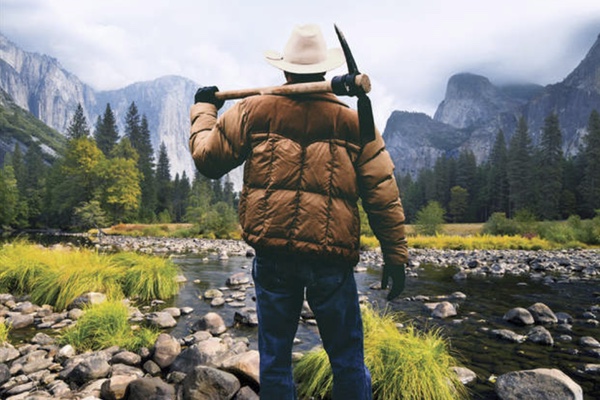The Incredible Role of Pure Golden Luck in the Acquisition of California

If you have ever wondered why Americans regard themselves as lucky, consider this: California, gold and all, was ceded to the United States by Mexico on 2 February 1848. Americans and Mexicans had been at war for two years following the US annexation of Texas, the Americans emerging as victors. The Treaty of Guadalupe Hidalgo, which ended hostilities, granted the US everything west of Texas and north to Oregon in exchange for fifteen million dollars. It also advanced what Americans had for some time been calling their Manifest Destiny – the God-given right to expand, to settle and to introduce democratic values from coast to coast.
 While
completing the unification of a vast land mass with beaches pounded
by waves from the Atlantic and Pacific oceans for just fifteen
million dollars might be regarded as ‘lucky’, what I am actually
trying to draw your attention to here is the date: 2 February 1848.
That is just nine days after James Marshall found his gold, and a
couple of months before anyone outside Coloma and the Sacramento
Valley – including the Mexicans – knew anything about it.
While
completing the unification of a vast land mass with beaches pounded
by waves from the Atlantic and Pacific oceans for just fifteen
million dollars might be regarded as ‘lucky’, what I am actually
trying to draw your attention to here is the date: 2 February 1848.
That is just nine days after James Marshall found his gold, and a
couple of months before anyone outside Coloma and the Sacramento
Valley – including the Mexicans – knew anything about it.
What is strangely odd about all this – creating an eerie impression that destiny did, indeed, lend a hand – is that the existence of a place called California, a place awash with gold, had been foretold as long ago as 1510 in a Spanish novel called Las Sergaz de Esplandián (The Adventures of Esplandián) by Garci Rodriguez de Montalvo.
De Montalvo’s mythical country is an island ruled by a queen called Calafia, where Amazonian goddesses fight with golden weapons and which ‘abounds with gold and precious stones and upon [which] no other metal is found.’ California, of course, is not an island, but for sixteenth-century Spanish explorers coming from the east, it might as well have been. Reaching it would have involved crossing the Atlantic Ocean to the east coast and then traversing the vast expanse of what is today the contiguous USA, including the Great Basin Desert and the Sierra Nevada mountain range to the east of California. Or negotiating the Mojave and Sonoran deserts to the south. Or heading north through the jungles and mountains of South America (once, as the conquistador Hernán Cortés did between 1519 and 1521, you had conquered the Aztecs). Or sailing around Cape Horn, which, in your tiny wooden vessel, and without accurate charts or maps, would have been almost suicidal.
After Cortés had defeated the Aztecs he wrote of an island to the northwest of Mexico that was probably the Baja California peninsula, the long appendage drooping parallel with northern Mexico from American California, or Alta California as the Spanish called it. Nevertheless, a land called California had become a reality. However, early explorers soon came to the conclusion that it was of little interest. A Portuguese expedition led by Juan Rodriguez Cabrillo in 1542 surveyed approximately four hundred miles of coastline, from what we now call San Diego to Point Reyes, about thirty miles north of San Francisco, and found neither the treasure nor the civilizations he had hoped for.
No one bothered much with California after that. Sir Francis Drake stopped by in 1579, claiming it for England and naming it Nova Albion. On finding only small tribes of Native Americans who had never heard of gold, he climbed back aboard the Golden Hind and continued westward on his circumnavigation of the globe.
In 1602 the explorer Sebastián Vizcaíno mapped large sections of coastline, naming features such as San Diego Bay, Santa Catalina Island and Monterey Bay. But his maps were not used for another 167 years, until the Spanish viceroy in Mexico City sent out an expedition of sailors, soldiers and a handful of priests to colonize the region. This involved mostly settling missions tasked with introducing the Native Americans to Christianity. Few other people ventured there from Mexico or Europe because, in reality, California was not seen as a desirable place to live. So resistant were people to going there that the Mexican government shipped convicts and outlaws to settle it.
After Mexico had declared independence from Spain in 1821, it began a policy of reducing the influence of the missions and redistributing their lands, giving away huge tracts in the hope of encouraging real colonists to develop them.
John Sutter, the man who commissioned James Marshall to build the sawmill in Coloma, was one of these beneficiaries. He had fled from debtors in Switzerland, leaving behind a wife and family, and arrived in California in 1839 via New York, Missouri, New Mexico, Oregon, Hawaii and Alaska. Once there, he ingratiated himself with the Spanish governor of California, lying about having been a captain in the Swiss Army (he had been an under-lieutenant in the Swiss reserves), and was appointed a captain of the militia, a mob that later proved itself worthless when confronted by real American soldiers. Identifying him as exactly the sort of man needed to help grow California into something useful, the Mexicans gave Sutter almost fifty thousand acres of land and appointed him an alcalde, a sort of magistrate with mayoral powers. In return, he was to protect the land and the Spanish-speaking population – the Californios – who lived on it.
The future for Sutter and Mexican California, then, was looking up. But not for long.
To say their fortunes were spoilt by the war with the United States and the discovery of gold would be an understatement. Imagine fleeing from debts in one country and securing vast amounts of land and potential wealth in another, only to find yourself in the middle of a gold rush that would see it all overrun. And imagine surrendering a piece of territory for a relative pittance only to find out that unimaginable wealth had been found there just nine days earlier and you didn’t know because telephones hadn’t been invented.
The total amount of gold estimated to have been mined in California to date is about 120 million ounces. At the time of writing, the price of gold is around thirteen hundred dollars an ounce. That represents a loss to Mexico of about 156 billion dollars at today’s value, taking into account the fact that the fifteen million it received for California in 1848 would be worth about 440 million today. (I readily admit that this is a highly simplistic view of the sums involved; for many years, as we shall see, the US government pegged the price of gold at twenty dollars sixty-seven cents an ounce and, later, at thirty-five dollars. But you get the picture.)
It seems incredible that for more than three hundred years no one had thought to properly explore and survey the foothills of the Sierra Nevada, but they simply hadn’t. There had been a small find in 1842 in the Santa Clarita Valley in modern-day Los Angeles County, but not enough to generate a full-blown gold rush.
Of course, you might argue that the Mexicans had lost the war and couldn’t have kept California anyway. Perhaps so. But would they have fought harder, fielded more troops, bought more weapons, called for assistance from other countries (Perfidious Albion, anyone?), if they had known how much gold was lying around and about the place?
They had already seen their indigenous forbears, the Aztecs, and their Peruvian neighbors, the Incas, lose fortunes in gold and silver to an occupying power, the Spanish (though the Spanish had seen this too – the Romans plundered much of their gold in the first century BC). Cortés in Mexico, and later Francisco Pizarro in Peru, destroyed their cultures and enslaved their peoples, emptying the hillsides of precious metals. In one month alone in 1532 – after Pizarro had taken hostage the Inca ruler Atahualpa – the Spaniards extracted seven tons of gold as ransom. The conquistadors killed Atahualpa anyway.
During the next hundred years, the amount of gold circulating in Europe increased fivefold. Spanish maritime records suggest that 160 tons of New World gold eventually found its way into the country’s vaults (and many times more silver). However, gold can be as much a curse as a blessing. The arrival of so much of it in Spain had disastrous consequences, causing rampant inflation and playing havoc with the country’s economy. Instead of investing the wealth in domestic enterprises, Spain spent it in other European countries, making them stronger while Spain became ever more reliant upon their exports.
At the end of the sixteenth century, Cortés wrote: ‘Although our kingdom could be the richest in the world for the abundance of gold and silver that have come into it and continue to come in from the Indies [Central and South America], it ends up as the poorest because it serves as a bridge across which gold and silver pass to other kingdoms that are our enemies.’
Should Mexico take some comfort from this? Would Mexico have made better use of Californian gold than Spain made of its gold from the New World? We will never know.